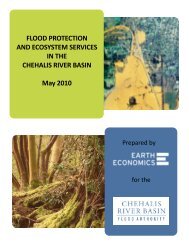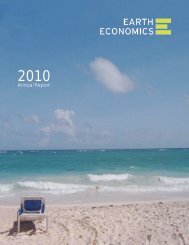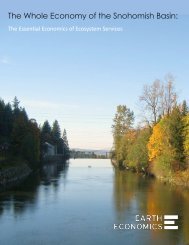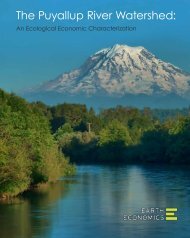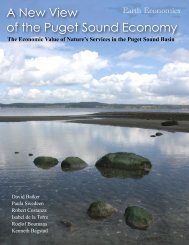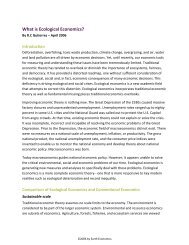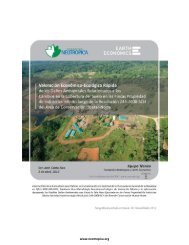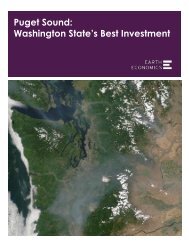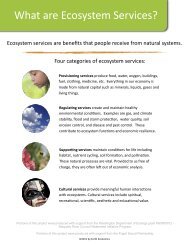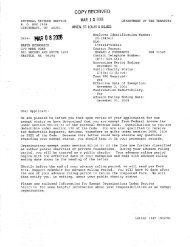The Spot Prawn Fishery: A Status Report - Earth Economics
The Spot Prawn Fishery: A Status Report - Earth Economics
The Spot Prawn Fishery: A Status Report - Earth Economics
You also want an ePaper? Increase the reach of your titles
YUMPU automatically turns print PDFs into web optimized ePapers that Google loves.
<strong>The</strong> <strong>Spot</strong> <strong>Prawn</strong> <strong>Fishery</strong>: A <strong>Status</strong> <strong>Report</strong><br />
abundance and distribution information suggests<br />
that sparse populations of prawns are widely distributed<br />
along the Oregon coast. To date, there<br />
have been no spot prawn scientific surveys. Most<br />
of the information regarding the status of the<br />
species is based either on fishers’ local ecological<br />
knowledge or has been extrapolated from the fisheries<br />
in California, Alaska, and British Columbia.<br />
History of the <strong>Fishery</strong><br />
Oregon’s spot prawn fishing grounds are small,<br />
clearly delineated, and “characterized by high<br />
relief rock bottoms” (ODFW 2000). <strong>The</strong>se small<br />
areas are regularly fished and are concentrated in<br />
prime habitat that lends itself to dense concentrations<br />
of spot prawns. Three areas are regularly harvested:<br />
the “prawn patch” off Nehalem Bay (35<br />
square miles), two sites off Cape Blanco (35 sq.<br />
miles), and the Rogue River (26 sq. miles). Other<br />
areas may be fished in any given year, but are generally<br />
fished in an exploratory fashion, with low<br />
catch per unit of effort rates and no concentration<br />
in any single area (ODFW 2000).<br />
<strong>The</strong> directed fishery for spot prawns was established<br />
in 1993, when a fisher/vessel with “California<br />
trawling technology” came to Oregon and<br />
“pioneered” the fishery (Bob Hannah, ODFW—<br />
Marine Program. Pers. comm., March 2001). Three<br />
vessels participated in the fishery and landed<br />
approximately 40,212 pounds—the first significant<br />
landings of spot prawns in the history of the fishery.<br />
<strong>The</strong> only other recorded landing prior to 1993<br />
was 74 lbs. by one vessel in 1989.<br />
<strong>The</strong> spot prawn fishery is open to both trawl<br />
and pots. Except in the 1994 season, trawlers have<br />
dominated landings. This is the primary gear type<br />
fished today. Pot landings peaked in 1994 at 20,398<br />
lbs., and trawl landings peaked in 1998 at 130,081<br />
lbs. As of 26 May 2000, the trawl fishery had landed<br />
14,158 lbs.; the pot fishery had zero landings.<br />
Analysis of both fish tickets and logbook data suggest<br />
that Oregon CPUE has been declining for the<br />
last three years. <strong>The</strong> Washington fishery has largely<br />
driven the rise and fall in Oregon landings during<br />
this time period. Logbook data illustrate that a large<br />
percentage of spot prawns landed in Oregon are<br />
actually caught in Washington. For example, in 1997,<br />
of the 86,510 lbs. landed, 16% came from Oregon<br />
waters, 84% from Washington. In 1998, the percentages<br />
were even more extreme: Of the 137,625 lbs.<br />
landed, 9% originated in Oregon, 91% in<br />
Washington.<br />
Nature of the <strong>Fishery</strong> Today<br />
<strong>Spot</strong> prawn landings in Oregon are sporadic and<br />
small. <strong>The</strong> Oregon Department of Fish and Wildlife<br />
(ODFW) is of the view that this may ultimately<br />
compromise the long-term ecological and economic<br />
viability of the fishery. <strong>The</strong>y have expressed<br />
concerns that the long-term conservation of spot<br />
prawns may be threatened by the fact that critical<br />
habitat—i.e., key fishing areas—are limited and<br />
may not be ecologically compatible with trawling.<br />
<strong>The</strong> Department stated in a recent document,<br />
“<strong>The</strong> small size of these areas cannot be overstressed.<br />
None of these sites are more than 6<br />
miles in diameter. <strong>The</strong> logbook data for 2000<br />
shows 2 boats making 80 tows within a triangular<br />
area only 8 miles across at its widest point.<br />
With trawling being focused in small, confined<br />
areas, habitat damage in these areas could be<br />
severe. This begs the question of how long spot<br />
prawn trawls can be used in an area of high relief<br />
before the habitat is altered to the point where it<br />
is no longer suitable for prawns” (ODFW 2000).<br />
<strong>The</strong> Oregon Developmental Fisheries Board (see<br />
description of the Board below) has not yet taken<br />
a position on the ecological vulnerability of the<br />
species, although local experience and knowledge<br />
seems to support the conservation concerns expressed<br />
by ODFW. According to fishers involved in<br />
the fishery, spot prawn areas fished in 1993 never<br />
recovered to initial abundance levels (Hannah,<br />
ODFW—Marine Program. Pers. comm., March<br />
2001).<br />
Examination of fishing in the “prawn patch” indicates<br />
that “heavy fishing” of a spot prawn population<br />
can drive down the localized population to the point<br />
where it is not economically viable to fish the area<br />
any longer. This analysis also gives some indication<br />
of the time it may take a population to recover after<br />
intensive fishing. According to ODFW (2000), “CPUE<br />
[in the prawn patch] in late 1993 was approximately<br />
25 lbs./hour SRE [single rig equivalents]. In 1997 a<br />
few tows in the area yielded 21 lbs./hour SRE. In 1998<br />
a few exploratory tows yielded no prawns, and in<br />
1999 there were no tows at the prawn patch recorded<br />
in logbooks. Year 2000 logbooks show renewed activity<br />
at the site and a CPUE of 21 lbs./hour SRE. This<br />
suggests that about three years may be necessary for<br />
spot prawn populations at a given site to recover to<br />
levels where fishing becomes worthwhile again.”<br />
Existing Management and<br />
Regulatory Systems<br />
<strong>Spot</strong> prawns in Oregon can be fished year-round,<br />
36



